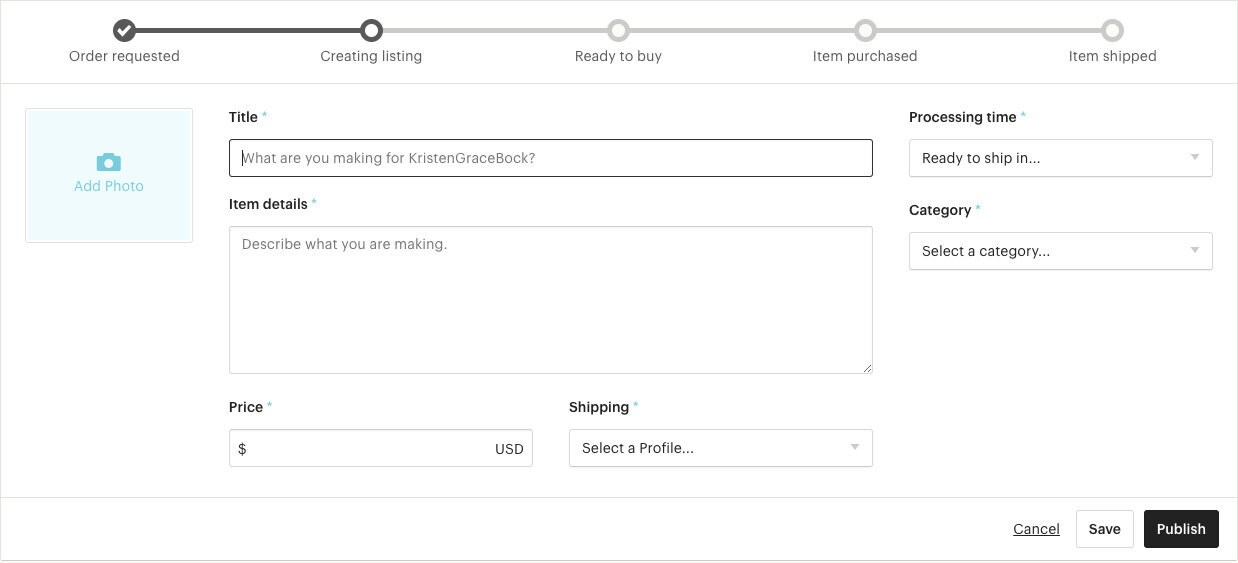Did you know that there are signals buried in your customer interactions that can translate into big opportunities for your business? Where do you look for these signals and how do they apply to your shop? Enter custom orders.
Offering custom items can be a great way to connect with your buyers, expand your inventory, or refine items that are already in your shop. For some sellers, custom orders seem intimidating (What if I have to say no?) and time-consuming (OMG: Bridezilla just changed her mind for the 400th time!). These six tips will help you manage your custom orders and grow your business without losing your mind.
1. Listen to Your Customer. Really Listen.
Every custom order begins as a conversation. Making sure that conversation includes all of the information you need from your buyer can mean the difference between a beautiful collaboration and a total disaster. Sending a standard form or questionnaire through the custom order system is a great way to get all of the nitty-gritty details like measurements, colors, materials, etc. for your custom order. But knowing exactly what your buyer thinks she wants isn’t always enough. Truly seeing things from your buyers’ point of view can help save stress, time, and money down the line.

Not sure that you know who you’re working with? If you’re able to answer these simple questions, you’re on the right track.
- How will this item be used? Who’s it for? Is it a gift? When does the customer need it?
- What’s most important to this buyer?
- What brought the buyer to your shop in the first place?
Knowing these answers will help you guide your buyer through the ordering process. For example, let’s say your buyer really wants an expensive pink angora cowl. Knowing that she plans to wear it with a dark wool jacket might lead you to suggest an equally luxurious, but less sheddy material.
2. Understand What You’re Capable of
Before taking on a new custom order, make sure you understand whether the order will fit into your existing workload. To ensure that you're comfortable making a commitment, ask yourself these questions:
- How long will it take me to complete this custom order?
- Does this project make logistical sense?
- Does this project fit within my existing brand?
- Do I have enough time in my schedule to take on extra work right now?
- Do I have the materials I need? If not, can I obtain them?
- Do I have the necessary skills to make this item? Can I adapt?
Remember, you are the expert — you know what you do and how you do it better than anyone else! If your buyer is asking for something unreasonable, suggest an alternative. If all else fails, you can always say no.
3. Know What You're Worth — And Charge for It
Custom orders take time, finesse, materials, and creative energy, so pricing needs to take all of these characteristics into account. Don't undercharge! Be sure to pay yourself fairly.
Mary Richmond of maryrichmonddesign — who’s been doing custom artwork for 30 years — says she’s learned to be very specific in her communication about pricing and how much extra work will cost. Because buyers sometimes change their minds or want additions or subtractions, it’s important to alter prices as necessary.
If you’re unsure how to price your items, read A Simple Formula for Pricing Your Work or Pricing Tips for Your Creative Business, which covers increasing prices depending on your experience level.
4. Bring Your Buyer on Board
During the custom order process, you’ll want to keep your buyer informed about the next steps. Before committing to the work, determine a payment and creation plan that clearly lays out the biggest steps for your buyer. While you may have some of this information in other parts of your shop, adding all of the details to the custom order thread will help to make sure you’re both on the same page. Consider these questions as you’re developing your plan:
- At what point in the process will you require payment? Do you need money upfront? Is there a deposit? What’s your refund and return policy?
- How will you share your work with the buyer? Do you provide a prototype, proof, or sample of your work? Do you allow revisions, and if so, how many?
- What's your processing time; when can the customer expect a completed item?
Your plan can be highly detailed or super flexible, but it’s important to make sure you’re protecting your business while accommodating your customer. Katy B from Sweet Bananas Art makes hand-painted art for kids. She says she goes back and forth a few times in Conversations to explain her process and learn what the customer wants in detail. “But I don't start working on anything until I've been paid,” Katy explains. “Regardless of what your plan is be sure to clue your buyer in from the start.”
5. Make Your Items Distinctly Yours
What is it about this custom item or your business that sets you apart? Is there a particular effect or detail you’re known for? What’s your expertise? Using your unique skills to provide excellent customer service and a human experience will inspire buyers to sing your praises. Keep your buyer in the loop throughout the production process (send a Conversation, use your Facebook, Twitter, Instagram, or other social media), let your personality shine, and add finishing touches (like beautiful packaging and thank-you notes). If you do all of these things, you're likely to turn the buyer — and her friends and family — into repeat customers. Watch our Building Your Brand video to get started.
6. Learn From Experience
So you went through your first custom order experience. How can you take what you learned and apply it to your shop? If you see trends in your custom orders, consider adding them as items in your shop, or think about how you can refine current items based on customer feedback. Really listening to your customers will help you grow, and your business will be better for it. Learn more about creating feedback loops in How to Grow Your Shop Without Losing Your Mind.
Are you an experienced or aspiring custom seller? Share your advice and what you've learned in comments.
 Words by Jamie DeLanghe
Words by Jamie DeLanghe
Jaime DeLanghe is a Product Manager at Etsy, leading a team of engineers, designers, and other superheroes to make custom orders on Etsy better for buyers and sellers. She loves telling stories, cooking, and teaching herself everything from crochet to calculus.




